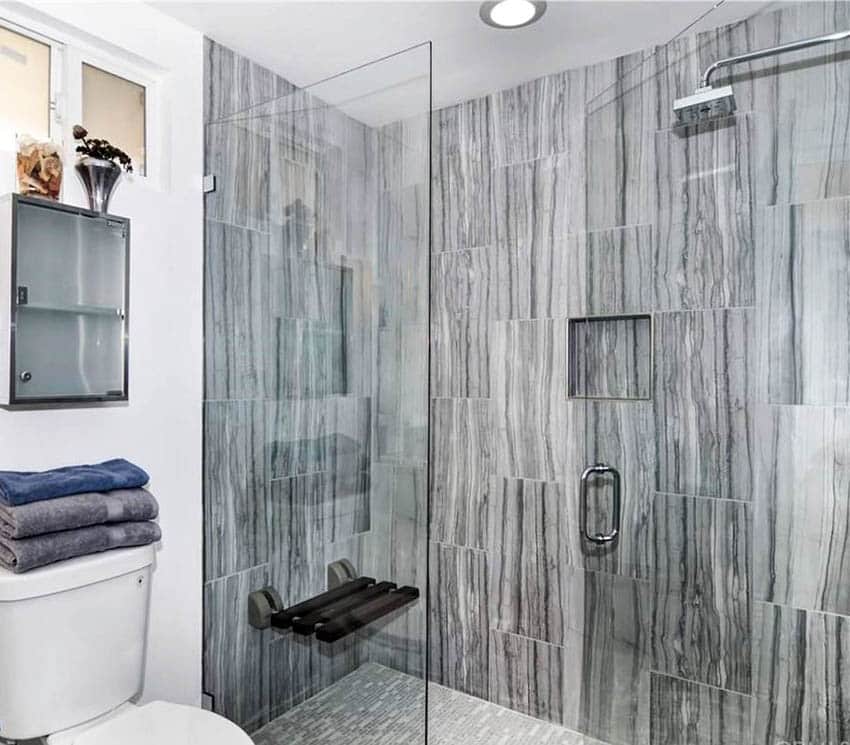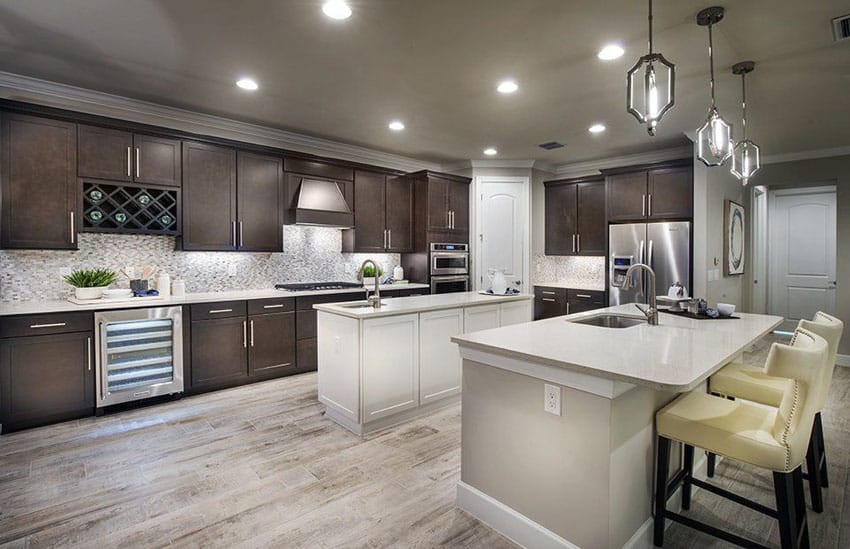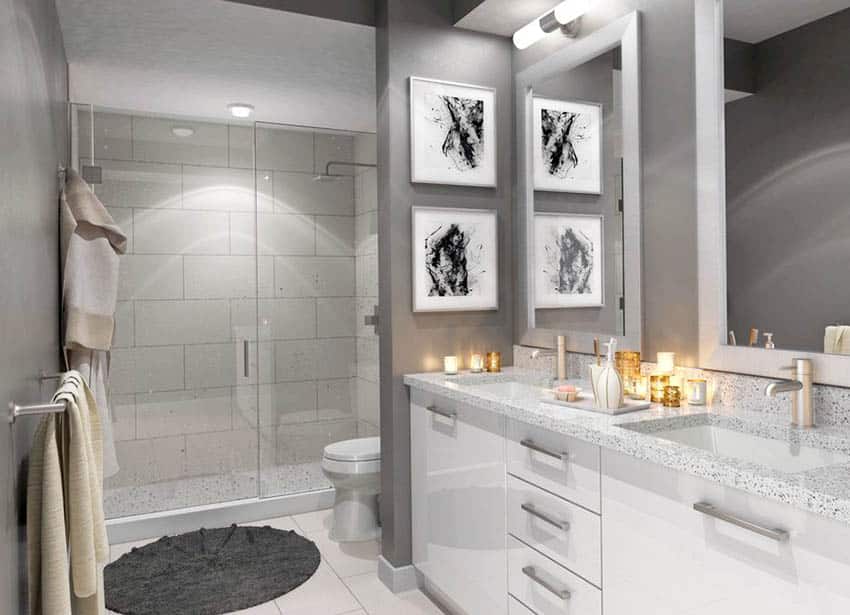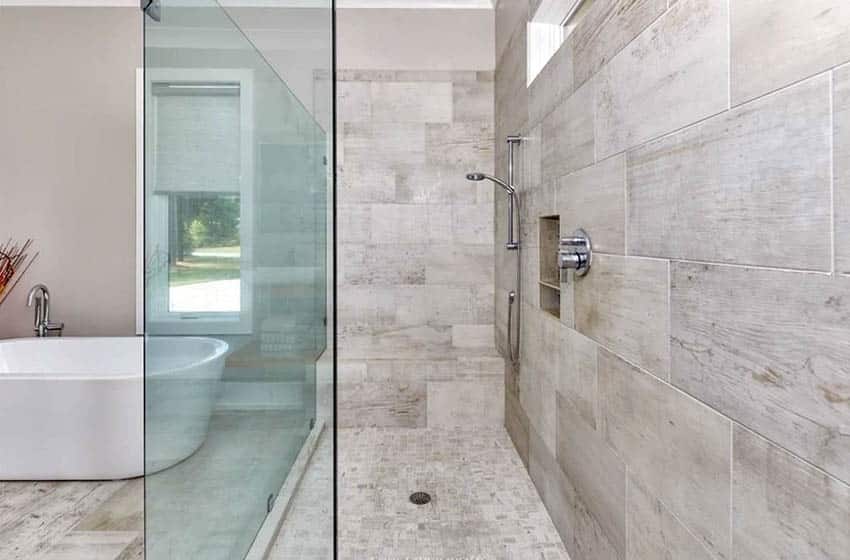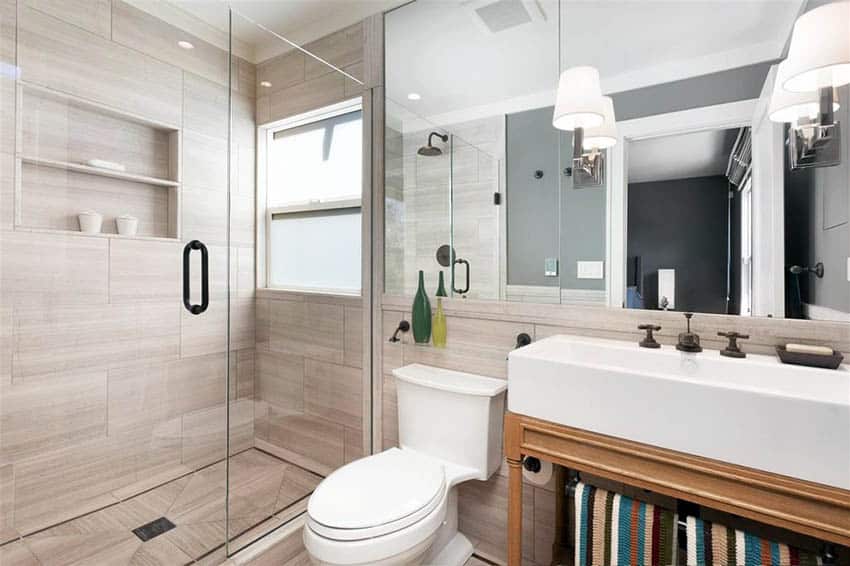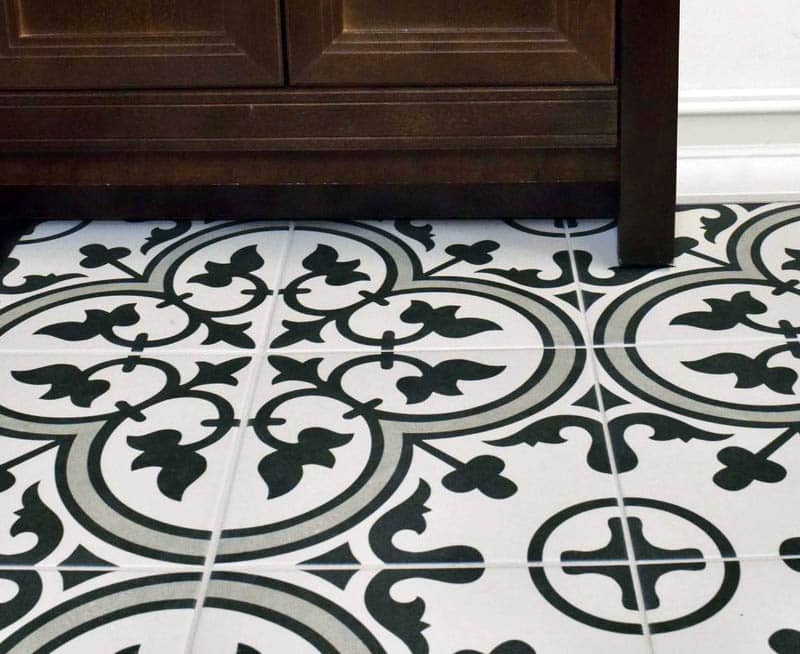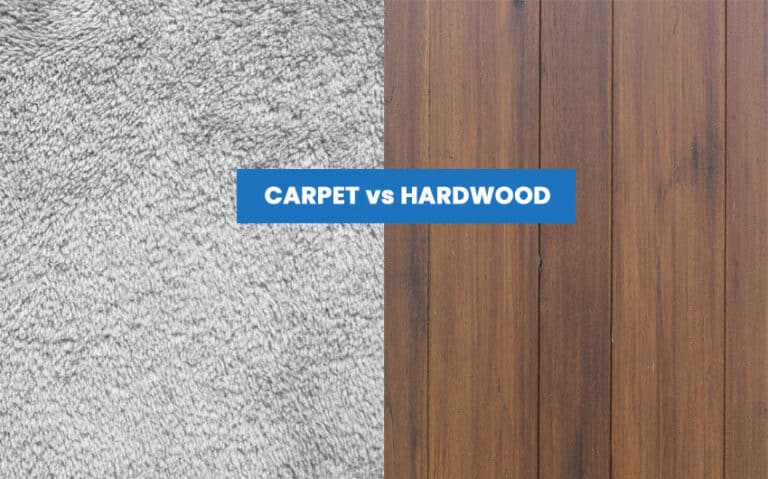How To Choose Porcelain vs Ceramic Tile for Interior Design
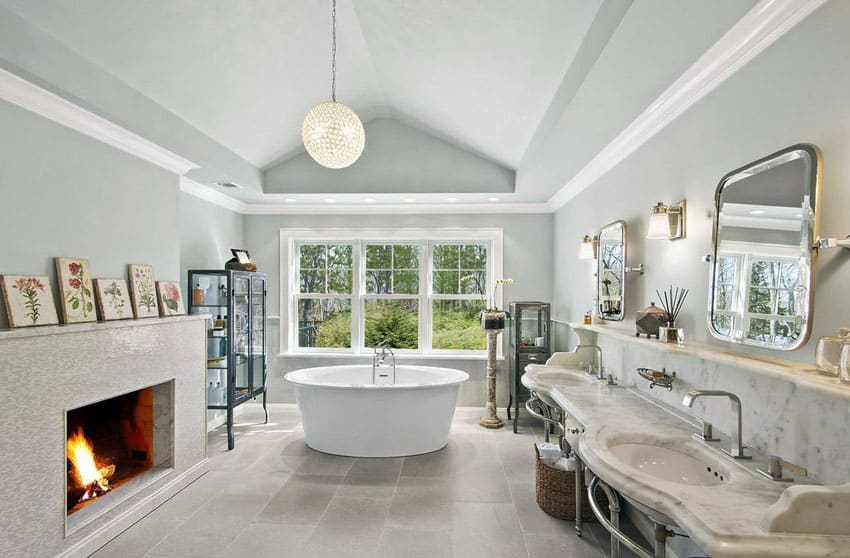
Porcelain and ceramic can be confusing words to the inexperienced. On this page, we’ll compare porcelain vs ceramic tiles and explain the unique qualities of each tile type, the pros and cons, and what tile to use.
All porcelain is ceramic but not all ceramic is porcelain. This is the easiest way to remember the difference between the two words commonly thrown around the interior design world. Both types of tiles are both technically ceramic; they just contain a few different qualities.
This is how you differentiate quarry tiles, glass tiles, and natural stone. Additionally, either is not highly recommended to be placed outdoors.
Quicklist: Porcelain Tiles vs Ceramic Tiles
Here is a comparison chart of the key differences between ceramic and porcelain tiles:
| Features | Porcelain Tiles | Ceramic Tiles |
|---|---|---|
| Composition | Made of white clay, sand & feldspar | Made from white, brown, or red clay |
| Durability | Dense and extremely durable; less porous | Less dense and durable |
| Water Resistance | Highly water-resistant and stain-resistant | Less water-resistant than porcelain tiles; needs glazing to be protected from water |
| Fire Resistance | Highly fire-resistant | Less fire-resistant than porcelain tiles |
| Color Options | Fewer color options | More color options due to glazing |
| Cost | More expensive | Less expensive |
| Ease of Cutting | Difficult to cut; may require professional installation |
Easy to cut with a wet saw or snap tile cutter; can be done at home |
| Maintenance | Requires less maintenance and upkeep over time |
Requires more maintenance and upkeep over time |
Difference Between Porcelain and Ceramic Tiles
First, we’ll cover the benefits of porcelain tile and then compare them with their differences vs ceramic tiles.
Porcelain Tile
Porcelain comes from the Italian word porcellana, meaning “cowrie shell” or “chinaware”. Fine china, typically expensive, is a white material with a strong, dense body.
The porcelain tile is made of white refined clay, sand, and feldspar. The color goes through the entire tiling or can have a glaze over the surface. Unglazed tilework showcases the natural color of the glazed stoneware. However, adding glaze to them will give you more color options.
Choose unglazed tile products for high-traffic areas, so signs of chippings, scratches, and wear are almost invisible as the color goes through the piece.
Porcelain material is durable due to its composition and high feldspar content. Additionally, they are much denser than decorative ceramics, making them less porous and higher on the durability scale. That said, they don’t absorb moisture and can last longer.
Additionally, they require less maintenance and upkeep over time and can withstand heavy traffic. All of these reasons make it a popular choice for bathroom designs because these can function well even in other moisture-prone areas. This material is also highly stain-resistant and fireproof.
When choosing flooring materials, porcelain tile stands out as an extremely durable option suitable for even the highest traffic areas, according to Avalon Flooring. With resistance to scratching, staining, and moisture, porcelain can withstand decades of wear in spaces like kitchens and bathrooms that experience daily use and contact with water. Even outdoors in open air, porcelain holds up against the elements.
However, it is difficult (but not impossible) to cut this material because of its density. This should be a consideration when you’re going to have a do-it-yourself project with porcelain. It’s recommended that you let the professionals handle its installation.
One of the drawbacks of this tiling is it can be expensive. For regular in-stock glazed products, you are looking at around $4 to $8 per square foot. On the other hand, custom-tiled applications can range from $4 up to $25 per square foot.
The installation runs about an extra $4 to $8 per square foot. Note that custom tiling might need patterns or unusual shapes, which can also incur additional professional installation fees.
Porcelain Rating
The tile industry follows the PEI Rating to identify the ideal location for a particular tilework, with ratings ranging from PEI 0 to PEI 5, 0 being the lowest and 5 the highest.
For instance, PEI 0 are in locations with no foot traffic and areas such as wall cladding. Glazed stoneware can occasionally be placed outdoors if it possesses an extremely high PEI (Porcelain Enamel Institute) Rating. The ratings will range from PEI 0 to PEI 5, 0 being the lowest and 5 the highest.
|
PEI RATING |
IDEAL LOCATION | EXAMPLE |
|
I |
locations with very light traffic | bathrooms, or areas without frequent use |
|
II |
locations with light traffic |
bathrooms and bedrooms |
|
III |
locations with light to moderate traffic |
kitchens and laundry rooms |
|
IV |
locations with moderate to heavy traffic |
hallway and commercial applications |
| V | locations with heavy traffic |
any room with heavy traffic and outdoor areas |
PEI 1 will be locations with very light traffic such as bathrooms, or areas without frequent use.
PEI 2 will be locations with light traffic such as bathrooms and bedrooms.
PEI 3 will be locations with light to moderate traffic which is most home usage.
PEI 4 will be locations with moderate to the heavy traffic which will be suitable for home usage and some commercial applications.
PEI 5 will be locations with heavy traffic which will be any usage in the home, outdoors, or commercial setting.
Typically, ceramic tiles rate around 3 to 4 on the scale while porcelain tiles at 3 to 5 on the scale. ANSI (American National Standards Institute) says that porcelain tile is a “ceramic tile that has a water absorption of 0.5% or less.”[Source: ANSI.org]
Ceramic Tiling
Ceramic tiles while less dense and durable than porcelain tiles. Choose decorative ceramics if you’re on a budget or planning to do the project yourself.
“Ceramic tile adds a unique personality to a space, and is one of the best ways to customize a home with a design element.” – Cowles Creative Publishing, Ceramic Tile Essentials
Ceramic tilework is semi-crystalline and amorphous. They are inorganic in nature. Ceramic tiled applications will not complete full vitrification, causing them to be porous. If the ceramic glaze is improperly applied, the surface can absorb water. They are often made from a white, brown, or red clay mixture.
These flooring materials, while less dense and durable than stoneware tiling, can be a great choice for they have a lower cost. It’s suitable for someone on a budget or planning to do the project themselves. These are the more economical versions of the glazed stone tiling. Ceramic tiles are much easier to cut with a wet saw for tiling, or a simple cutter for tiles, which can be done at home.
Ceramic tilework is also known to be less water resistant than porcelain tiled surfaces. However, they can be made less susceptible to staining and more resistant to water penetration by glazing them. It adds a protective layer to the tiling application.
Ceramic tilework are also cheaper than glazed stoneware tiled surfaces because they are less expensive to manufacture and install. Typically, this tiling will cost about $3 to $7 per square foot.
Similar to porcelain, the prices of decorative ceramics can increase significantly when custom pieces and designs are requested. The installation cost will run about $4 to $8 per square foot but could be higher if the tilework needs custom patterns and designs.
Common Features of Porcelain and Ceramic Tilework
In this section, we share the common characteristics shared by stoneware and decorative ceramics.
Both are waterproof.
Though the ceramic and porcelain tile types have water-resistant qualities, the grout used for sealing will be a more vulnerable substance. The grout used for sealing tiling is a porous substance and, therefore, able to take on staining and moisture.
It is important to properly seal and maintain the grout to keep the tile’s beauty and water-resistant quality. If care is not taken, it can potentially cause harm to the tilework or molding of the grout itself.
Both are heavy.
The stoneware and ceramic materials are both extremely heavy flooring options. Typically, they are best used in ground-floor applications. The weight also makes the installation of each of the materials a little more expensive due to the added labor costs. For tiling to be installed properly on an upper level, make sure to get an inspection to make sure the building can hold loads of the material.
Which Type of Tiles Should I Use?
When it comes to glazed stoneware vs decorative ceramics for a budget-friendly product, choose ceramic tilework. If money and labor cost is no object, stoneware tiles is a popular choice for bathroom floor tile and other living spaces like living rooms, bedrooms, and kitchens.
Porcelain works well in heavy traffic areas in the home and even outdoor areas if the proper rating is followed. If doing a second-story space with tiling, decorative ceramics is the better way to go, but only in an extremely small space. Inspection needs to be done to ensure the structure can bear the load.
According to home improvement writer Angela Bunt, porcelain tiles can better mimic the appearance of other materials, such as wood and natural stone, providing additional design flexibility
Each product offers a variety of different patterns and colors since either product can be cut and glazed. Glazed stoneware has a thorough color, so will look better when it is scratched or chipped. If this is going to be a do-it-yourself project, stick to the ceramic tilework.
This is because it will be easier to cut and less expensive, so if there are mistakes it is less detrimental. If doing porcelain floors it is highly recommended to leave that to the professionals.
For more related content on tilework, visit our guide on types of floor tiles.

